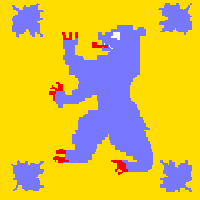As I mentioned some time ago, it will be based on the Jarania Campaign design of Stephen Luscumbe. I will however be using my own setting and will be tailoring it to my own troop availability.
 I have divided Afristan into four basic areas. Each is around one of the four major rivers (Cango, Vile, Tyger and Wazu). . . . (click on map twice for larger image). And, yes, I know that the map needs more work, especially in naming the districts.
I have divided Afristan into four basic areas. Each is around one of the four major rivers (Cango, Vile, Tyger and Wazu). . . . (click on map twice for larger image). And, yes, I know that the map needs more work, especially in naming the districts.My intention is for each player to be responsible for one of these "river basins". They will be constantly needing to visit all of the districts in their area in order to keep the "rebellion index" down.
At the moment, my plan is for each player to start the game with the following:
- one Captain
- one Lieutenant (unassigned)
- one British (or Scottish) 20-man platoon (with Lt. & Sgt.)
- one British (or Scottish) 10-man squad (with NCO)
- one Sepoy 20-man platoon (with Indian leaders)
- one mule train for supplies and/or wounded (with drovers)
I've been painting up Pathans. When those are finished, I will start on some Dervishes and Beja . . . then on to the Zulus . . . and finally the Egyptians (who I'll call something else).
Afristan is nominally ruled by said "Egpytian" types . . . but they've so alienated everyone that they need British help in keeping the peace since almost the whole place is about ready to burst into rebellion.
Each river basin has one "controlled" district (the ones with the green settlements. Each port settlement must always have one full platoon of "British" troops; and each up-river fort must always have at least one "British" squad in residence. These troops are not part of the player's "field forces" . . . but will be available for defense in case they are attacked. The ports will also have one field gun and one Gatling gun (with crews). The inland forts will have a Gatling gun with crew.
I have not yet decided quite how I want to work movement. I might settle for simple area movement or I might have it depend upon terrain type. Something I still want to ponder.
As with the Jarania rules, the "rebellion index" in a district will climb each turn that they have not been visited. In most districts it will climb by one each turn; but the districts with a "mission" (purple tents) are more volatile.
When the player's "field force" enters a district, 1d20 will be rolled, if the number rolled is below the "rebellion index", the district will be in rebellion . . . and the difference in numbers will indicate how many units they are facing. . . . thus the longer they stay away, the more likely there will be trouble.
When they "show the flag" in a district, the "rebellion index" will drop to 2 (and start climbing again as soon as they leave.
I will be using something akin to the "reinforcements" mechanism from Jarania but not quite the same.
More to come later.
-- Jeff

I am following your progress with interest. I still have my copies of the old Courier magazine when they did a series of articles on a Colonial campaign about the "False Prophet of the San Juans", which was based on a map of the San Juan Islands up near your neck of the woods. It was one of those (set of) articles that always got me thinking of doing something similar.
ReplyDeleteI've got a lot of old Couriers . . . what issues was this series in?
ReplyDelete-- Jeff
It's a 3-parter, starting in Vol V Number 4 ()July/Aug 1984), part 2 in Vol. V Number 5, and the last part in Vol. V Number 6.
ReplyDelete